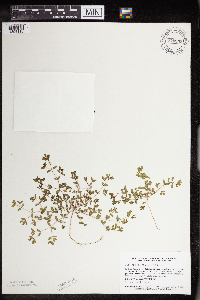Euphorbia geyeri
|
|
|
|
Family: Euphorbiaceae
Geyer's Sandmat, more...Geyer's sandmat
[Chamaesyce geyeri (Engelm. & Gray) Small] |
FNA 2016, Ackerfield 2015, Allred and Ivey 2012 Duration: Annual Nativity: Native Lifeform: Forb/Herb General: Mat-forming annual herbs, from a taproot; stems prostrate or slightly ascending, 4–25 cm long; herbage glabrous. Leaves: Opposite along the stems, on 1-2 mm petioles; blades oblong to ovate, 4-12 mm long and 2-6 mm wide, with a slightly asymmetric base, one side of the base expanded into a small rounded auricle, and entire margins; leaf underside light gray-green and lighter than the upper surface; stipules 1 mm long, usually distinct but occasionally fused at the base, usually deeply parted into 3 or more filiform segments. Flowers: Has the highly modified flower structure characteristic of Euphorbias. Structures called cyathia appear to be individual flowers, but are composed of fused-together bracts forming a cup (involucre), with peripheral nectary glands which are often subtended by petal-like bracts called petaloid appendages. Within the cup there is a ring of inconspicuous male flowers, each reduced to a single stamen. Out of the middle protrudes a single, stalked female flower which lacks petals. In E. geyeri, the cyathia (flower-like structures) are solitary in the leaf axils near the branch tips. Involucres are broadly bell-shaped, 1.5 mm high, and glabrous, with 4 green to reddish oblong or round cup-shaped glands around the edge, each with a round to pointed, white to red-tinged petaloid appendage (appendages sometimes absent or rudamentary); 5-20 staminate flowers. Fruits: Capsules globose-ovoid, 2 mm high, 3-celled, glabrous; containing 3 smooth, ovoid, ashy-white seeds, 1.5 mm long, rounded to bluntly angled in cross section, with a smooth brown line from top to bottom on the side facing the center of the capsule. Ecology: Found in sand barrens, river banks, and disturbed sandy or gravelly areas, below 5,000 ft (1524 m); flowers mid-summer to early fall. Distribution: c N. Amer., from MT, WY, UT and NM, east to MI, IN, MO, and MS Notes: This species belongs to the Chamaesyce subgenus of Euphorbia. Some treatments, even recent ones, continue to treat Chamaesyce as a separate genus even though molecular evidence places it within Euphorbia. Chamaesyce spp are distinct based on their leaves which are always opposite and and often have asymmetric bases; cyathia (flower structures) in leaf axils, not at branch tips, and usually with petaloid appendages; and stipules present and not gland-like. E. geyeri is distinguished by being a low, mat-forming annual without any hairs on its stems, leaves, or capsules; ovate leaves 4-12 mm long and no more than twice as long as they are wide, with smooth (entire) edges; seed pods less than 3 cm high containing 3 smooth seeds (without ridges); and cyathia (flower structures) usually with small petaloid appendages 0.5 mm long. Two varieties are recognized; var. geyeri is widespread throughout the species' range and has petaloid appendages; var. wheeleriana is found in a small area along the southen border of New Mexico, near El Paso, and lacks petaloid appendages. Euphorbia geyeri resembles E. glyptosperma (both being entirely glabrous), but that species has finely toothed leaves near the stem tips and strongly angled, transverse-ridged seeds, whereas E. geyeri has entire leaves and smooth, rounded seeds. It is wise to make a collection whenever ID to species is needed, as Chamaesyces are difficult to identify in the field, and multiple species of the genus will commonly grow side-by-side. Ethnobotany: Unknown Etymology: Euphorbia is named for Euphorbus, Greek physician of Juba II, King of Mauretania; geyeri honors Dr. Albertus L. Geyer (1894-1969), a South African journalist, diplomat, and plant collector with a special interest in succulents. Editor: AHazelton 2017 Glabrous annual, branched from the base, usually prostrate, 1-3 dm; lvs oblong to broadly elliptic, 5-10 mm, entire, broadly rounded to shallowly retuse at the apex; appendages inconspicuous, short-ovate, rarely more than twice as long as the gland (measured radially); stamens 5-17 per involucre; fr 2 mm; seeds not compressed, smooth, roundly 3-angled, 1.3-1.6 mm. Inland sandy prairies and dunes; Ind. to N.D. and e. Mont., s. to Okla., Tex., and N.M. July-Oct.(Chamaesyce g.) Gleason, Henry A. & Cronquist, Arthur J. 1991. Manual of vascular plants of northeastern United States and adjacent Canada. lxxv + 910 pp. ©The New York Botanical Garden. All rights reserved. Used by permission. |


































































































